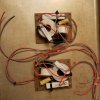While typing the previous post on these speakers I decided to show the impact of installation locations, mic placement, and such on the real listening experience on any set of speakers.
Here are two measurements showing how placement impacts performance:

Black Line: Response of installed right speaker from the most common listening position on my patio
Red Line: Response of same speaker in anechoic environment (9-1/2 ft above ground, over 23 ft from house or other hard surfaces)
I matched the output levels at 440Hz because that is the frequency I use to adjust for sensitivity calculations for 2.83V @ 1M.
It is clear that boundary reinforcement dramatically increased the output in the bass range by over 12dB of gain. Also, the treble is harsher due to the many hard reflective surfaces all around the speaker and the listener. I knew this would happen, hence my decision to design the cabinet loading on the woofer portion to have a weaker bass output in an anechoic space and cut the midrange as it would also boost.
Here's all of the measurements I took of both the left and right speaker from several spots on my patio: left seat, right seat, between seats, directly between the speakers, out in the yard, and standing on the front edge of my patio:

I also included the anechoic measurement and placed it's level based on the SPL at 1kHz being about average with the other curves. I set the levels of the other curves so they are almost all identical at 200Hz.
Notice the dip at 400Hz is almost the same from every measurement location and either speaker. However, it shifts from below 400Hz to above 400Hz based on the distance of the microphone from the reflective wall behind the seating. The widest about of variation in output is in the 500 - 800Hz range where either mic placement or using a different speaker created a variation of nearly 20dB SPL.
This just demonstrates how critical the acoustical environment in which you are installing speakers needs to be taken into account. You cannot look at a response chart on the web and assume that is how they well sound in your installation. However, you could look at the response charts of two speakers and get an understanding of how one might sound when compared to the other.
Here are two measurements showing how placement impacts performance:
Black Line: Response of installed right speaker from the most common listening position on my patio
Red Line: Response of same speaker in anechoic environment (9-1/2 ft above ground, over 23 ft from house or other hard surfaces)
I matched the output levels at 440Hz because that is the frequency I use to adjust for sensitivity calculations for 2.83V @ 1M.
It is clear that boundary reinforcement dramatically increased the output in the bass range by over 12dB of gain. Also, the treble is harsher due to the many hard reflective surfaces all around the speaker and the listener. I knew this would happen, hence my decision to design the cabinet loading on the woofer portion to have a weaker bass output in an anechoic space and cut the midrange as it would also boost.
Here's all of the measurements I took of both the left and right speaker from several spots on my patio: left seat, right seat, between seats, directly between the speakers, out in the yard, and standing on the front edge of my patio:
I also included the anechoic measurement and placed it's level based on the SPL at 1kHz being about average with the other curves. I set the levels of the other curves so they are almost all identical at 200Hz.
Notice the dip at 400Hz is almost the same from every measurement location and either speaker. However, it shifts from below 400Hz to above 400Hz based on the distance of the microphone from the reflective wall behind the seating. The widest about of variation in output is in the 500 - 800Hz range where either mic placement or using a different speaker created a variation of nearly 20dB SPL.
This just demonstrates how critical the acoustical environment in which you are installing speakers needs to be taken into account. You cannot look at a response chart on the web and assume that is how they well sound in your installation. However, you could look at the response charts of two speakers and get an understanding of how one might sound when compared to the other.













